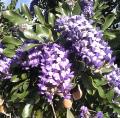
DMT-Nexus member

Posts: 1843 Joined: 28-Jun-2012 Last visit: 20-Jul-2021
|
Thin Layer Chromatography (TLC) for Cacti IDing cacti and "taste-testing", I'm wondering if anyone has successfully run TLC on cacti material. I've done it on extracted mascaline but not plant material. From what Dreamer042 said, there needs to be a "significant" quantity to test. Does anyone know how much this might be? Or better yet, does anyone have instructions for TLC of cacti? Many, many thanks, Wap + ---- + ---- + ---- + ---- + ---- + ---- + ---- + ---- DMT Nexus Research ---- + ---- + ---- + ---- + ---- + ---- + ---- + ---- +
|
|
|
|
|

DMT-Nexus member
Posts: 908 Joined: 06-May-2012 Last visit: 07-Mar-2020
|
I would be interested in this too. I had some small samples of lophophora, trichocereus, and a few other plants TLC'd and it came back inconclusive since they were smaller samples (100-1000mg) I would love to know what the best quantity to give for a sample would be. 3... 2... 1... BLAST OFF!!!!FFO TSALB ...1 ...2 ...3 My grafting guide
|
|
|

Homo discens
Posts: 1827 Joined: 02-Aug-2012 Last visit: 07-Aug-2020
|
Bumping this thread out of curiosity. A rundown on the best way to test cacti with TLC would be very useful! 
|
|
|

DMT-Nexus member

Posts: 14191 Joined: 19-Feb-2008 Last visit: 22-Nov-2025 Location: Jungle
|
More than quantity, it should be related to concentration.
So even if you use a tiny amount, just break it up properly and then soak with very small amount of methanol. Ethanol should work too. Then use a couple of mililiters of that to soak the plate, and run the plate using the eluent methanol:ammonia at 100:2.5 ratio.
I don`t remember to be honest since it`s been a while but if for some reason some plant acid or oil is staining the plate too much and its hard to see any spot, you can try instead to do like a dry tek mixing the plant material with calcium hydroxide before adding the ethanol/methanol and loading the plate with that.
I`m supposing you entheogenerator have previous experience with TLC? If not, be sure to check the explanation thread in my signature. I can expand on whatever you ask, but not sure what exact explanation you are looking for.
|
|
|

Homo discens
Posts: 1827 Joined: 02-Aug-2012 Last visit: 07-Aug-2020
|
endlessness wrote:More than quantity, it should be related to concentration.
So even if you use a tiny amount, just break it up properly and then soak with very small amount of methanol. Ethanol should work too. Then use a couple of mililiters of that to soak the plate, and run the plate using the eluent methanol:ammonia at 100:2.5 ratio.
I don`t remember to be honest since it`s been a while but if for some reason some plant acid or oil is staining the plate too much and its hard to see any spot, you can try instead to do like a dry tek mixing the plant material with calcium hydroxide before adding the ethanol/methanol and loading the plate with that.
I`m supposing you entheogenerator have previous experience with TLC? If not, be sure to check the explanation thread in my signature. I can expand on whatever you ask, but not sure what exact explanation you are looking for. I have a basic understanding of how TLC works, but I do not have any hands-on experience with it as of yet... At least not until those substance testing kits from TLConcious are finished!  I was mostly curious as to how large of a sample would be needed, and it appears you have answered that question pretty thoroughly! 
|
|
|

DMT-Nexus member
Posts: 3207 Joined: 19-Jul-2011 Last visit: 02-Jan-2023
|
yea, it seems extracting the plant matter and testing the extract is the way to go. My wind instrument is the bong
CHANGA IN THE BONGA!
樹
|
|
|

Dreamoar

Posts: 4711 Joined: 10-Sep-2009 Last visit: 15-Dec-2025 Location: Rocky mountain high
|
I ran all sorts of samples from 10 mg to 2 g on 3 seperate plates, none of them showed anything at all on the plates. It seems that there is more to it than simple concentration of miniscule samples. What I did was finely chop up and soak the samples of cactus skin in the very minimal amount of solvent necessary, between <1-6 ml depending on the sample size. All the samples soaked overnight. I made it as concentrated as I could get it and still be able to suck it up into the micro-pipette. The only thing that did show up on the plates was the peruvian torch extract I was using as a mescaline standard and that appeared fine on all the plates. This consisted of some saturated hcl salting water from a 250g extraction. It really does seem that the best bet for testing is to extract or at least use a fairly large sample size. Edit: Is it possible that mescaline and other cactus alks are not soluble in IPA?
|
|
|

DMT-Nexus member

Posts: 1843 Joined: 28-Jun-2012 Last visit: 20-Jul-2021
|
Does anyone have access to these papers? "Cactus alkaloids XVII. Thin-layer chromatography of Dansylated non-phenolic β-phenethylamines" http://www.researchgate....henolic_-phenethylamineshttp://www.ncbi.nlm.nih....mp;from=/5081650/related+ ---- + ---- + ---- + ---- + ---- + ---- + ---- + ---- DMT Nexus Research ---- + ---- + ---- + ---- + ---- + ---- + ---- + ---- +
|
|
|

DMT-Nexus member

Posts: 1843 Joined: 28-Jun-2012 Last visit: 20-Jul-2021
|
Oh, well here's a good find. Thin Layer Chromatography of Alkaloids, Cacti: http://books.google.com/...LYCQ&ved=0CDEQ6AEwBAAnd here's a link to a table of the systems they tested: http://books.google.com/...cti&output=html_textAre any of those systems available commercially? + ---- + ---- + ---- + ---- + ---- + ---- + ---- + ---- DMT Nexus Research ---- + ---- + ---- + ---- + ---- + ---- + ---- + ---- +
|
|
|

DMT-Nexus member

Posts: 1843 Joined: 28-Jun-2012 Last visit: 20-Jul-2021
|
And better yet, Here's a simple explanation and methodology of TLC for mescaline. "Methods for testing peyote cactus/ mescaline" By the United Nations www.unodc.org/pdf/publications/st-nar-19.pdfwearepeople attached the following image(s):  cacti _reagent_TLC.jpg (307kb) downloaded 92 time(s).+ ---- + ---- + ---- + ---- + ---- + ---- + ---- + ---- DMT Nexus Research ---- + ---- + ---- + ---- + ---- + ---- + ---- + ---- +
|